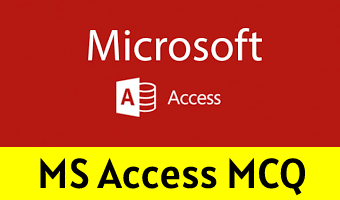
MS Access MCQ – IBPS RRB Computer Awareness Questions and Answers.
Q.1. Which of the following relation algebra operation do not required the participation tables to be union-compatible?
(A) Union
(B) Intersection
(C) Difference
(D) Join
Ans . D
Q.2. Which of the following is not a property of transactions?
(A) Atomicity
(B) Concurrency
(C) Isolation
(D) Durability
Ans . B
Q.3. Relational Algebra does not have
(A) Selection operator
(B) Projection operator
(C) Aggregation operators
(D) Division operators
Ans . B
Q.4. Checkpoints are a part of
(A) Recovery measures
(B) Security measures
(C) Concurrency measures
(D) Authorization measures
Ans . C
Q.5. Tree structures are used to stored data in
(A) Network model
(B) Relational model
(C) Hierarchical model
(D) File base system
Ans . A
Q.6.The language that requires a user to specify the data to be retrieved without specifying exactly how to get it is
(A) Procedural DML.
(B) Non-Procedural DML.
(C) Procedural DDL.
(D) Non-Procedural DDL.
Ans . B
Q.7. Precedence graphs help to find an AC14/AT11 Database Management System
(A) Serializable schedule
(B) Recoverable schedule.
(C) Deadlock free schedule.
(D) Cascade less schedule.
Ans . A
Q.8. The rule that a value of a foreign key must appear as a value of some specific table is called a
(A) Referential constraint
(B) Index
(C) Integrity constraint
(D) Functional dependency
Ans . A
Q.9. The clause in SQL that specifies that the query result should be sorted in ascending or descending order based on the values of one or more columns is
(A) View
(B) Order by
(C) Group by
(D) Having
Ans . B
Q.10. What is disjoint less constraint?
(A) It requires that an entity belongs to no more than one level entity set.
(B) The same entity may belong to more than one level.
(C) The database must contain an unmatched foreign key value
(D) An entity can be joined with another entity in the same level entity set
Ans . A
11. Full form of DBMS
(A) Date base management
(B) Document Base Management System
(C) Digital Base Management System
(D) None of them
Ans . A
Q.12. It is an abstraction through which relationships are treated as higher level entities
(A) Generalization
(B) Specialization
(C) Aggregation
(D) Inheritance
Ans . C
Q.13. A relation is in ………..if an attribute of a composite key is dependent on an attribute of other composite key.
(A) 2NF
(B) 3NF
(C) BCNF
(D) 1NF
Ans . B
Q.14.What is data integrity?
(A) It is the data contained in database that is non-redundant
(B) it is the data contained in database that is accurate and consistent
(C) it is the data contained in database that is secured.
(D) It is the data contained in database that is shared.
Ans . B
Q.15. What are the desirable properties of a decomposition
(A) Partition constraint
(B) Dependency preservation
(C) Redundancy
(D) Security
Ans . B
Q.16. In an E-R diagram double lines indicate
(A) Total participation
(B) Multiple participation
(C) Cardinality N
(D) None of the above
Ans . A
Q.17. The operation which is not considered a basic operation of relational algebra is
(A) Join
(B) Selection
(C) Union
(D) Cross product
Ans . A
Q.18. Fifth Normal form is concerned with
(A) Functional dependency
(B) Multivalued dependency
(C) Join dependency
(D) Domain – key
Ans . C
Q.19. Block-interleaved distributed parity is RAID level
(A) 2
(B) 3
(C) 4
(D) 5
Ans . D
Q.20. Immediate database modification technique uses
(A) Both undo and redo.
(B) Undo but no redo.
(C) Redo but no undo.
(D) Neither undo nor redo.
Ans . A



